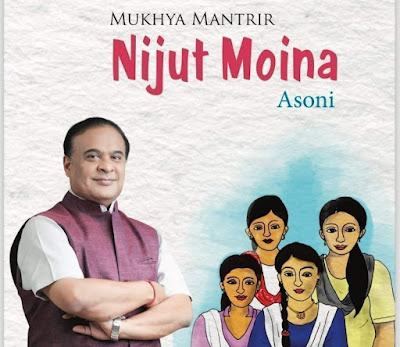Medieval History of Assam : Relevance of Chutiya Kingdom in the History of Assam
Hello, aspirants are you preparing for APSC Prelims and Mains exam as well as other Assam Govt exams? If yes, then you must be aware of the most important Assam history the period of Medieval History of Assam for the upcoming Assam competitive exam preparation. Therefore every aspirants need to know the detail information of History of Assam for Assam Govt exams. In this regard “World_Polity” decides to provide you the most important dynasty of Assam history the Chutiya Kingdom of Assam : Origin & History of Chutiya Kingdom for APSC Mains exam. Infact the Medieval History of Assam will be a key topic in the history section for the upcoming exams.
Origin & History of Chutiya Kingdom
Medieval History of Assam : Relevance of Chutiya Kingdom in the History of Assam
In this article we have provided you the most important Assam History note on Medieval History of Assam : Relevance of Chutiya Kingdom in the History of Assam. So, read this most important article on Assam History for Competitive Exams. This Medieval History of Assam is extremely important and should be a part of your preparation. Infacf the Ruling Dynasty of Ancient Assam the Chutia kingdom their relevance & downfall is very important for any upcoming Assam govt exams.
Rulling Dynasties Of Assam – Assam History Questions And Answers
In order to succeed in the prestigious competitive examination, it is important that the aspirant has access to the Assam History notes & materials. Specially the toppers of APSC or other Assam govt exams recommend that aspirant start their preparation with the Assam GK topics such as Assam History questions and answers on major rulling dynasties of Assam for the upcoming exams.
Chutiya Kingdom of Assam : Origin & History of Chutiya Kingdom for APSC Mains
The Chutiya Kingdom (pronounced Sutia/Sutiya) was a medieval kingdom in northeastern India that existed from the 12th century until the 16th century. The kingdom was primarily located in present-day Assam, in the northeastern part of India. The Chutiya dynasty ruled over this region and had its capital at Sadiya.
The Chutiyas were a Tibeto-Burman ethnic group, and their kingdom was known for its military prowess and cultural development. They had conflicts with neighboring kingdoms, particularly the Ahom Kingdom, the Kachari Kingdom, and the Kamata Kingdom. Despite facing invasions and political challenges, the Chutiyas managed to maintain their independence for several centuries.
The Chutiya Kingdom eventually came under the dominance of the Ahom Kingdom in the 16th century. The Ahoms defeated the Chutiyas and integrated their territory into their own kingdom. Today, remnants of Chutiya history can be found in the form of archaeological sites, temples, and other cultural artifacts in Assam.
Origin of Chutiya Kingdom :
The origin of the Chutiya Kingdom can be traced back to the migration of the Chutiya people to the region of present-day Assam in northeastern India. The exact origins of the Chutiyas are not definitively known, but they are believed to have migrated from regions of present-day Tibet or Myanmar.
The Chutiyas were a Tibeto-Burman ethnic group and established their kingdom in the 12th century. They settled in the Brahmaputra Valley, particularly in the eastern part of Assam. The region was known for its fertile lands and strategic location, which likely attracted the Chutiyas to establish their kingdom there.
Over time, the Chutiya Kingdom grew in power and influence, expanding its territory and establishing its dominance over the surrounding areas. The Chutiyas developed a distinct culture, which blended elements of the indigenous tribes of Assam and their own unique traditions.
It is worth noting that historical records and information about the early years of the Chutiya Kingdom are scarce. Much of what is known about the Chutiyas comes from later historical accounts, inscriptions, and archaeological findings.
History and Foundation of Chutiya Kingdom :
The history of the Chutiya Kingdom dates back to the 12th century and spans approximately four centuries until its integration into the Ahom Kingdom in the 16th century.
The founder of the Chutiya Kingdom was Birpal or Birpalita, also known as Birpal. He is credited with establishing the early Chutiya state in the Brahmaputra Valley of present-day Assam, India, in the 12th century.
Birpal was a leader of the Chutiya tribe, which was a Tibeto-Burman ethnic group. Under his leadership, the Chutiya Kingdom expanded its influence and consolidated its power in the region. Birpal and his successors laid the foundation for the Chutiya dynasty, which would rule the kingdom for several centuries.
While Birpal is considered the founder of the Chutiya Kingdom, it is important to note that historical records from that period are limited, and the details of his life and the early years of the kingdom may not be fully accurate or well-documented. The information available is based on later accounts, inscriptions, and archaeological findings.
Here’s an overview of the history of the Chutiya Kingdom :
1. Foundation and Early Years : The Chutiya Kingdom was founded by Birpal, also known as Birpalita, in 1187 CE (12th century). The exact details of the kingdom’s establishment are not well-documented, but it is believed that Birpal led the Chutiya people to settle in the Brahmaputra Valley of present-day Assam, India. The kingdom gradually expanded its influence in the region.
2. Expansion and Consolidation : Under subsequent rulers, such as Sutuphaa and Ratnadhwajpal, the Chutiya Kingdom continued to expand its territories and establish its dominance. They engaged in conflicts with neighboring kingdoms, such as the Ahom Kingdom and the Kamata Kingdom, while also forging alliances with other regional powers.
3. Cultural and Artistic Development : The Chutiya Kingdom witnessed cultural and artistic growth during its existence. They developed their unique architectural style, as evident in the construction of temples and monoliths. The Chutiyas also made significant contributions to literature, language, and religious practices in the region.
4. Ahom Invasions and Decline : The Chutiya Kingdom faced continuous invasions from the powerful Ahom Kingdom, led by kings like Suhungmung. These invasions, combined with internal conflicts and succession disputes, weakened the Chutiya Kingdom over time. The Ahoms gradually eroded the Chutiya control and influence in the region.
5. Integration into the Ahom Kingdom : In the 16th century, the Ahoms succeeded in their conquest of the Chutiya Kingdom. The Ahom king, Susenphaa, defeated the last Chutiya king, Satyanarayan, and assimilated the Chutiya territories into the Ahom Kingdom. The integration marked the end of the Chutiya Kingdom as an independent entity.
The history of the Chutiya Kingdom is relatively less documented compared to other major kingdoms in India. Much of the information about the kingdom comes from later historical accounts, inscriptions, and archaeological findings. These sources provide valuable insights into the cultural, political, and historical dynamics of the Chutiya Kingdom and its significance in the northeastern region of India.
List of Chutiya Kings & Rulers :
The Chutiya Kingdom had a line of rulers from its establishment in the 12th century until its eventual integration into the Ahom Kingdom in the 16th century.
Here is a list of some of the prominent kings of the Chutiya Kingdom :
| NO. | Kings Name | Years | Capital |
|---|---|---|---|
| 1 | Birpal | 1187-1210 | Sadiya |
| 2 | Ratnadhwajpal | 1210-1250 | Sadiya |
| 3 | Vijayadhwajpal | 1250-1270 | Sadiya |
| 4 | Vikramadhwajpal | 1270-1285 | Sadiya |
| 5 | Gauradhwajpal | 1285-1305 | Sadiya |
| 6 | Sankhadhwajpal | 1305-1325 | Sadiya |
| 7 | Mayuradhwajpal | 1325-1343 | Sadiya |
| 8 | Jayadhwajpal | 1343-1360 | Sadiya |
| 9 | Karmadhwajpal | 1360-1380 | Sadiya |
| 10 | Satyanarayan | 1380-1400 | Sadiya |
| 11 | Laxminarayan | 1400-1420 | Sadiya |
| 12 | Dharmanarayan | 1420-1440 | Sadiya |
| 13 | Pratyashnaarayan | 1440-1465 | Sadiya |
| 14 | Yasnarayan | 1465-1480 | Sadiya |
| 15 | Purnadhabnarayan | 1480-1500 | Sadiya |
| 16 | Dharmadhwajpal | 1500-1522 | Sadiya |
| 17 | Nityapal | 1522-1524 | Sadiya |
Chutiya Kingdom and it’s Relevance in the History of Assam ::
The Chutiya Kingdom holds historical significance for the northeastern region of India, particularly in Assam. Although it was a relatively smaller kingdom compared to its contemporaries like the Ahom and Koch dynasties, the Chutiya Kingdom played a crucial role in shaping the political, cultural, and historical landscape of Assam.
Here are some aspects highlighting the relevance of the Chutiya Kingdom ::
1. Political Resistance against the Ahom Kingdom : One of the major contributions of the Chutiya Kingdom was its long-standing resistance against the expansion of the Ahom Kingdom. The Ahoms, after establishing their rule in Assam, sought to consolidate their authority over the entire region. However, the Chutiyas fiercely resisted Ahom aggression for several centuries. Their resistance posed a significant challenge to the Ahoms and prevented them from completely subjugating the Chutiya Kingdom.
2. Promotion of Culture and Language :
The Chutiyas made significant contributions to the cultural and linguistic development of Assam. They promoted the use of the Assamese language and were instrumental in the development of the early Assamese script. Their patronage of literature and art led to the growth of Assamese literature, and the works produced during their rule became an essential part of Assamese cultural heritage.
3. Trade and Economic Prosperity :
The Chutiya Kingdom was strategically located along the trade routes connecting the Ahom Kingdom, present-day Myanmar, and Bengal. They actively engaged in trade with these regions, facilitating the exchange of goods, ideas, and cultural influences. The prosperity derived from trade routes bolstered the economic development of the Chutiya Kingdom, allowing them to maintain a stable and thriving society.
4. Architectural and Artistic Contributions :
The Chutiyas were patrons of art and architecture, leaving behind notable structures that still stand as testimonies to their cultural legacy. The Talatal Ghar, a three-storied palace in present-day Sivasagar, Assam, is a prime example of their architectural expertise. It served as a military installation and reflects the strategic importance of the Chutiya Kingdom.
5. Influence on Assamese Identity :
The Chutiya Kingdom played a vital role in the formation of Assamese identity. The resistance put up by the Chutiyas against the Ahoms and their contributions to language, literature, and culture contributed to the collective consciousness of the Assamese people. It fostered a sense of regional identity and pride, which continues to shape Assam’s cultural fabric.
Overall, the relevance of the Chutiya Kingdom lies in its contributions to the cultural heritage, understanding historical dynamics, exploring ethnic identity, and tracing the historical lineage of northeastern India, specifically in Assam.
Downfall of Chutiya Kingdom :
The downfall of the Chutiya Kingdom can be attributed to several factors, including external invasions, internal conflicts, and the rise of neighboring powers. Here are some key factors that led to the downfall of the Chutiya Kingdom:
1. Ahom Invasions : The Chutiya Kingdom faced repeated invasions from the powerful Ahom Kingdom, which was expanding its territory in the region. The Ahoms, under the leadership of their king, Suhungmung, launched multiple military campaigns against the Chutiya Kingdom and gradually weakened its control over the region.
2. Internal Conflicts and Succession Disputes : Internal conflicts and succession disputes among the Chutiya rulers weakened the kingdom’s stability and ability to resist external threats. In some instances, rival claimants to the throne fought against each other, further exacerbating the internal divisions within the kingdom.
3. Kamata Kingdom Expansion : The Kamata Kingdom, another regional power in Assam, also posed a challenge to the Chutiya Kingdom. The Kamatas, under their king, Sukhrampha, expanded their influence and territory, which further encroached upon the Chutiya Kingdom’s domain and contributed to its decline.
4. Loss of Allies : The Chutiya Kingdom also suffered setbacks due to the loss of allies and weakening alliances. As neighboring powers grew stronger, the Chutiyas found themselves increasingly isolated and lacking support from other regional entities.
5. Integration into the Ahom Kingdom : Ultimately, the Ahoms succeeded in conquering the Chutiya Kingdom in the 16th century. The Ahoms, with their superior military strength and strategic advancements, absorbed the Chutiya territory into their own kingdom, marking the end of the Chutiya Kingdom as an independent political entity.
It’s important to note that historical records from that period are limited, and the exact details and chronology of events leading to the downfall of the Chutiya Kingdom may not be fully precise. However, the factors mentioned above played a significant role in its ultimate decline and integration into the Ahom Kingdom.
Must visit : Role of Darrang in the Freedom Movement of India
Must visit :: Decline and Fall of the Ahom Kingdom
Now World_Polity is on every platform you can connect with us by just clicking the below social media links. Thank You.
• Subscribe our Youtube channel
• Join our Facebook Page
• Join our telegram Channel
* Recent Top Most Searches :
• History of Medieval Assam from Sukaphaa to Purandar Singha
• Ahom-Mughal Conflicts : The History of Assam
Well if you like the article on Chutiya Kingdom of Assam : Origin & History of Chutiya Kingdom for APSC Mains, do comment & show your support by sharing it to the other aspirants and if there is any query you are welcome to ask.



